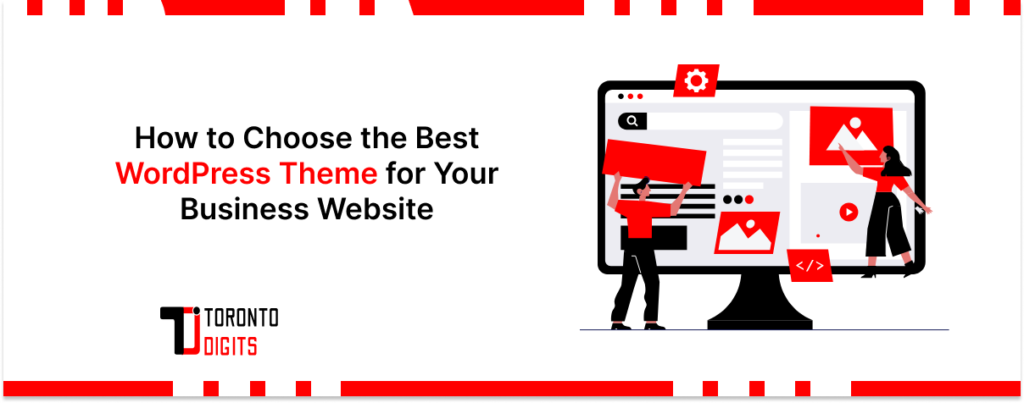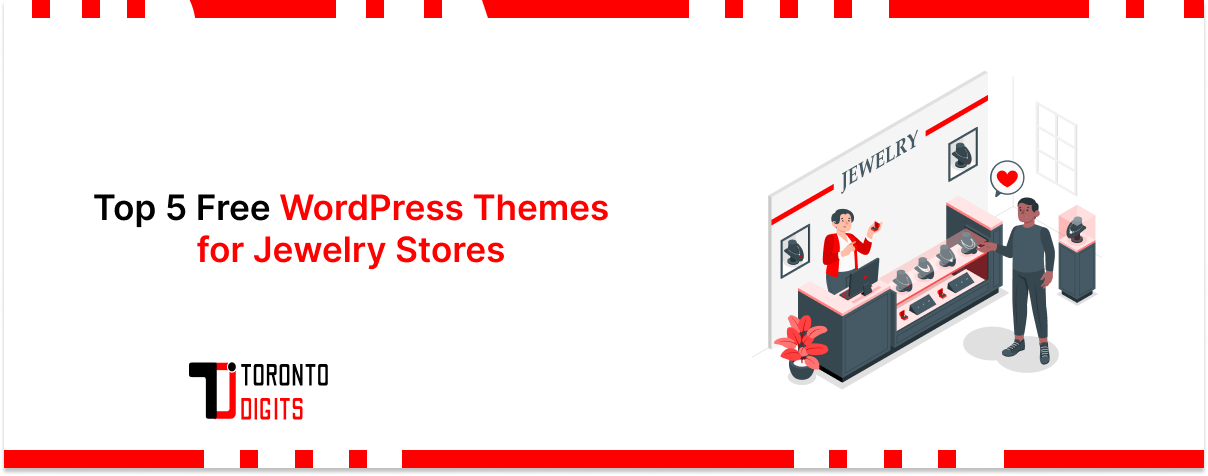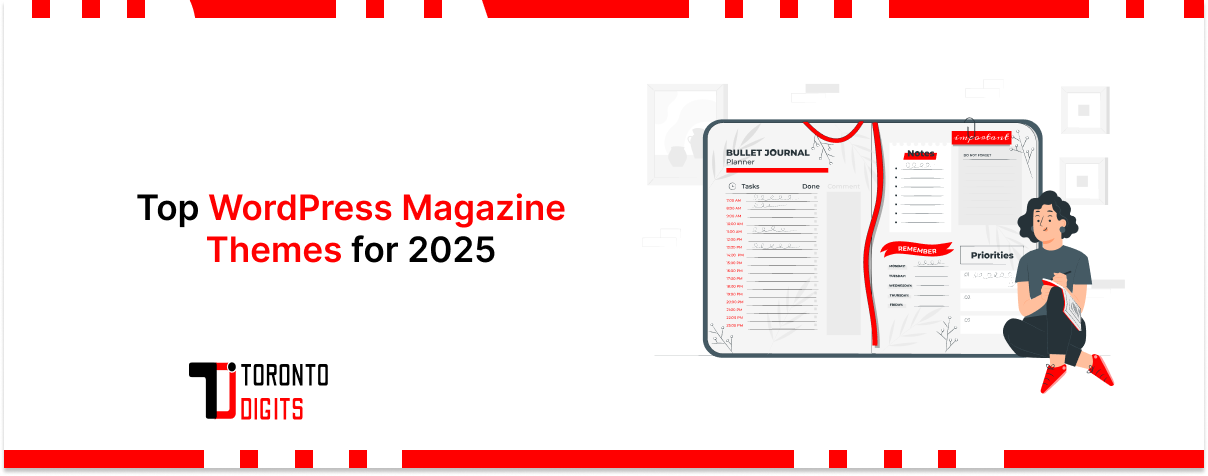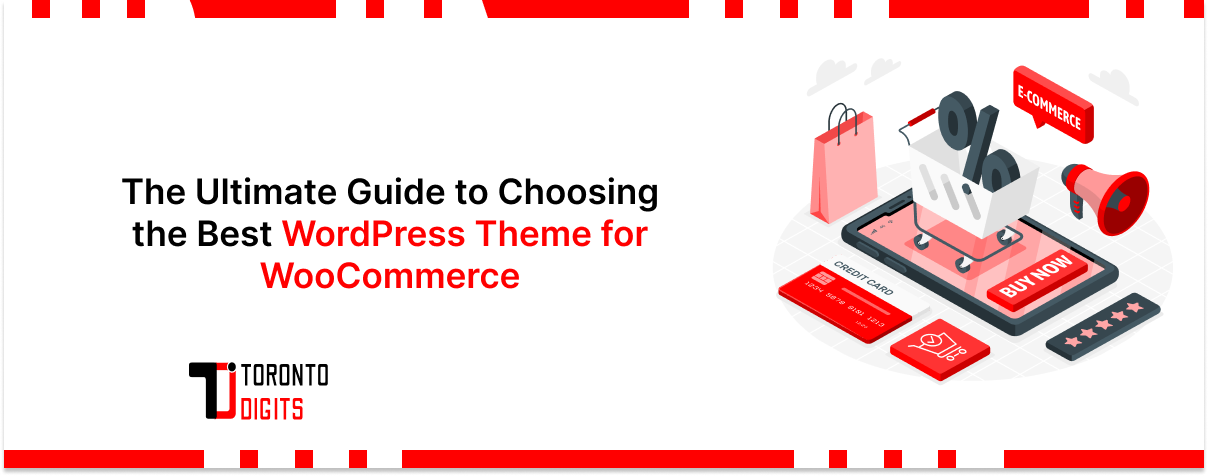Choosing the right WordPress theme for your business website is crucial for creating a professional online presence. With thousands of themes available, it can be overwhelming to decide which one fits your needs. To make the process easier, consider key factors like design, responsiveness, SEO, scalability, support, updates, customization, and plugin compatibility. Here’s a breakdown of what to look for:
Way to Choose the Best WordPress Theme for Your Business Website
1. Design: Aligning with Your Brand Identity
Your website’s design is the first thing visitors notice, so it’s essential to pick a theme that represents your brand well.
- Aesthetics: Choose a theme that reflects your brand’s identity and conveys the right message.
- Color Scheme: Stick to a color palette that aligns with your brand for consistency.
- Typography: Ensure the font style is readable and matches your brand’s tone.
- Layout: A well-structured layout enhances user experience and makes navigation easy.
- Imagery: Use high-quality images that support your brand’s message and resonate with your audience.
2. Responsiveness: Mobile-Ready for All Devices
A responsive theme ensures your website looks great on desktops, tablets, and smartphones. With the growing number of mobile users, a mobile-friendly theme is non-negotiable.
3. SEO: Boosting Your Search Engine Ranking
A well-coded, SEO-friendly theme improves your chances of ranking higher on search engines. Look for themes that load fast, have clean code, and follow SEO best practices.
4. Scalability: Preparing for Future Growth
Your business will evolve, and so should your website. Pick a theme that allows you to expand by adding new features and functionalities without extensive customization.
5. Support and Updates: Staying Compatible
Regular updates keep your website secure and compatible with the latest WordPress version. Choose a theme backed by a reliable developer who offers ongoing support and updates.
6. Customization: Tailor Your Website Without Coding
A good theme should allow you to change colors, fonts, and layouts easily. Themes with drag-and-drop builders make customization simple, even for non-tech-savvy users.
7. Plugin Compatibility: Enhancing Functionality
Ensure the theme supports essential plugins like SEO tools, contact forms, eCommerce solutions, and security features. A theme with broad plugin compatibility saves you from potential headaches down the road.
Picking the right WordPress theme is a balance between aesthetics, functionality, and future-proofing your website. Take your time to explore options, test demos, and ensure the theme aligns with your business goals.
For a visual guide, check out this helpful video on choosing a WordPress theme:
How to Choose a WordPress Theme in 2024 (9 Key Factors)
1. Understanding Your Business Needs
Before diving into theme selection, define your business goals. Are you building an eCommerce store, a portfolio, a blog, or a corporate website? Your choice of theme should align with your industry and business objectives.
2. Features to Look for in a WordPress Theme
When choosing the best WordPress theme, consider the following features:
a. Responsiveness and Mobile-Friendliness
With most users browsing on mobile devices, a fully responsive WordPress theme ensures a seamless experience across all screen sizes.
b. Speed and Performance Optimization
A lightweight, fast-loading theme improves user experience and SEO rankings. Avoid themes with excessive animations or bloated code that slow down your site.
c. SEO-Friendly Design
The best WordPress themes are coded with SEO best practices, making it easier for search engines to crawl and index your site.
d. Customization Options
Look for themes that allow easy customization through WordPress Customizer or page builders like Elementor. This ensures flexibility in how to customize a WordPress theme with Elementor without requiring coding skills.
e. Compatibility with Plugins
Your theme should work seamlessly with essential plugins such as WooCommerce, Yoast SEO, and WPForms.
3. Free vs. Premium WordPress Themes: Which One to Choose?
If you’re wondering which is the best free WordPress theme, options like Astra, GeneratePress, and Neve offer excellent features for startups. However, premium themes provide more flexibility, advanced customization, and dedicated support.
4. How to Buy WordPress Themes?
For those looking for premium options, here’s how to buy WordPress themes:
- Visit trusted marketplaces like ThemeForest, Elegant Themes, or TemplateMonster.
- Read reviews and check demo versions before purchasing.
- Ensure it includes regular updates and customer support.
5. Top 10 Best WordPress Themes for Businesses
Choosing the right WordPress theme can make a huge difference in how your business website looks and performs. Whether you need a sleek design, built-in page builders, or eCommerce functionality, there’s a perfect theme for you. Here are the top 10 business-friendly WordPress themes that stand out in terms of flexibility, performance, and ease of use.
1. Astra – The All-in-One Business Theme
Astra is one of the most popular and lightweight WordPress themes. It’s highly customizable, SEO-friendly, and works seamlessly with page builders like Elementor and Beaver Builder. Whether you run a small business, agency, or eCommerce store, Astra adapts to your needs.
2. OceanWP – Feature-Rich & Versatile
OceanWP is a powerful theme suitable for business websites, eCommerce stores, and portfolios. It offers fast performance, built-in SEO optimization, and a range of demo templates to get your site up and running quickly.
3. Neve – Perfect for Small Businesses & Agencies
Neve is a modern, fast-loading theme designed for small businesses, startups, and agencies. It’s mobile-friendly, integrates with WooCommerce, and works well with popular page builders.
4. Amaryllis – Sleek & Professional
Amaryllis is a stylish business theme with a drag-and-drop homepage, custom widgets, and Jetpack support. It’s great for creating a strong online presence with minimal effort.
5. Vantage – Ideal for eCommerce & Portfolios
Vantage is a highly flexible theme that pairs well with WooCommerce, making it a great choice for online stores. It also includes page builder support for easy customization.
6. Customizr – User-Friendly & eCommerce-Ready
Customizr is a visually appealing theme with smooth navigation and eCommerce-friendly features. It’s fully responsive, making it an excellent choice for businesses looking to sell products online.
7. Rara Business – Clean & Corporate-Friendly
Rara Business is a professional-looking theme perfect for corporate websites. It features a clean design, built-in SEO optimization, and customizable sections to highlight your services.
8. Avada – The Bestselling Theme with a Built-in Page Builder
Avada is a premium theme that comes with the Fusion Builder, allowing you to create custom layouts effortlessly. It’s highly customizable and ideal for businesses of all sizes.
9. Divi – Drag-and-Drop Simplicity
Divi is known for its powerful Divi Builder, which lets you design your website visually. It’s perfect for businesses that want full creative control without needing coding skills.
10. BeTheme – Packed with Pre-Built Layouts
BeTheme includes over 600 pre-designed templates, making it easy to create a professional business site. It comes with the BeBuilder for smooth customization.
Bonus: More Themes with Page Builders
- The 7 – Comes with the Elementor page builder
- Salient – Uses WPBakery page builder
- Beaver Builder Theme – Built for Beaver Builder users
Each of these themes brings something unique to the table. Whether you’re looking for speed, customization, or seamless WooCommerce integration, these WordPress themes will help you build a powerful and professional business website.
6. How to Make a WordPress Website Using a Theme?
To set up your website using a WordPress theme:
- Install WordPress on your hosting.
- Navigate to Appearance > Themes > Add New.
- Upload and activate your chosen theme.
- Customize the design using WordPress Customizer or Elementor.
- Install necessary plugins for added functionality.
7. How to Create a Theme for WordPress?
If you want complete control over your website’s design and functionality, creating a custom WordPress theme is a great option. While it does require some coding knowledge, it allows you to build a theme that perfectly matches your business needs. Here’s a step-by-step guide to making your own WordPress theme:
1. Understanding the Basics
Before diving in, you should have a basic understanding of:
- HTML, CSS, and JavaScript for front-end design.
- PHP for handling WordPress functionality.
- WordPress Template Hierarchy, which determines how different pages and elements are displayed.
Some essential files you’ll work with include:
- style.css – Defines the styles for your theme.
- index.php – The main template file for displaying content.
- header.php & footer.php – Files for the site’s header and footer.
- functions.php – Allows you to add custom functions to your theme.
2. Setting Up Your Theme Folder
To start building your theme:
- Navigate to your WordPress installation’s wp-content/themes/ directory.
- Create a new folder with a unique name for your theme.
3. Creating Core Files
Inside your theme folder, add these essential files:
- style.css – This file should include theme metadata (name, author, version, description) at the top using comments.
- index.php – The main template file that controls how content is displayed.
- header.php & footer.php – These define the structure for your website’s header and footer.
- functions.php – Used to add custom features and functions.
4. Designing Your Layout
Now, you can start structuring your website’s layout using HTML and CSS. Key elements to focus on include:
- Header & Navigation – Ensure your menus and branding elements are well-placed.
- Content Area – Structure the main section where your posts and pages will appear.
- Sidebar & Widgets – Include sidebars for additional navigation or information.
- Footer – Add useful links, copyright info, and contact details.
5. Implementing WordPress Functionality
To make your theme dynamic, you need to integrate WordPress template tags in your PHP files. These tags allow WordPress to:
- Display blog posts, pages, and categories dynamically.
- Load the correct content structure based on the template hierarchy.
- Show comments, archives, and widgets in the right places.
6. Adding Customization Options
To make your theme user-friendly, consider adding a Customizer section, allowing users to:
- Change colors, fonts, and backgrounds.
- Upload a logo or modify the header layout.
- Adjust settings directly from the WordPress dashboard.
7. Testing and Refining Your Theme
Before launching your theme, test it on multiple devices and browsers to ensure:
- Responsiveness – The theme adapts to different screen sizes.
- SEO Optimization – Proper HTML structure and meta tags help search engines understand your content.
- Accessibility – Make sure your site is usable for people with disabilities.
Alternatives to Coding from Scratch
If coding a theme from scratch sounds too complex, consider these options:
- Starter Themes: Pre-built templates like Underscores (_s) give you a solid foundation to customize.
- Theme Frameworks: Platforms like Genesis or Bootstrap provide structured components to speed up development.
- Visual Theme Builders: Plugins like Elementor or Divi allow you to design a theme without writing code.
Creating a custom WordPress theme gives you full control over your site’s design and performance. Whether you build from scratch or use a framework, make sure your theme is responsive, SEO-friendly, and user-friendly. With the right approach, you can develop a professional-looking website that stands out.
8. How to Create a Premium WordPress Theme
For those interested in developing and selling themes, how to create a premium WordPress theme involves:
Key Features of a High-Quality Business WordPress Theme
To truly stand out, a top-tier business theme should include:
1. Well-Structured Design & Responsive Layout
A great business theme should look professional and work flawlessly across all devices. Responsive design ensures your website adapts to different screen sizes, from desktops to smartphones, providing an excellent user experience.
2. Customization Made Easy
No one wants a one-size-fits-all theme. The best business themes leverage the WordPress Customizer API, allowing users to personalize colors, fonts, layouts, and more—without touching a single line of code.
3. Feature-Packed for Business Success
Premium themes often come with essential business-friendly features, such as:
- Advanced Post Formats (videos, galleries, quotes)
- Custom Widgets (for testimonials, contact forms, and CTAs)
- WooCommerce Compatibility (for businesses selling products or services online)
- SEO Optimization (clean code, structured data, and proper heading hierarchy)
4. User Experience & Performance
A business theme should be:
Easy to navigate – Intuitive menus help users find information quickly.
Accessible to everyone – Following web accessibility guidelines improves inclusivity.
Fast-loading – Optimized images, clean code, and caching ensure smooth performance.
5. Tested for Reliability & Security
Before launching, premium themes undergo rigorous testing, including:
✔ Cross-browser compatibility (Chrome, Firefox, Safari, Edge)
✔ Device testing (desktop, tablet, mobile)
✔ Security enhancements to prevent vulnerabilities
6. Documentation & Support
The best business themes come with detailed user guides and dedicated support forums to help users set up and troubleshoot issues easily.
7. Competitive Pricing & Value
While free themes are great for startups, premium themes offer better design, functionality, and long-term support—making them a worthwhile investment for serious businesses.
By keeping these factors in mind, you can choose a WordPress theme that not only looks great but also helps your business grow online.
Choosing the Perfect WordPress Theme FAQ
How to choose the perfect WordPress theme?
When selecting a WordPress theme, make sure it comes with clear setup guides and a helpful community. Well-documented themes make customization easy, saving you time and effort. Plus, having an active community means you can quickly find solutions if you run into any issues. Always choose a theme with solid documentation and reliable support!
What is the best WordPress theme to use?
13 Best WordPress Themes in 2025 (Best Picks)
- OceanWP.
- Hestia.
- Hello Elementor.
- Storefront.
- Breakthrough Pro.
- Avada.
- GeneratePress.
- Blossom Themes.
Does a WordPress theme matter?
The theme you choose for your WordPress website will dictate more than just how it looks. It can improve the site’s loading speed and user experience and even make search bots like it, boosting your SEO.
How do you choose themes?
Before you choose your theme you should have a clear idea of the goal of your event, who is attending, and what you want your guests to ‘take away’ from the occasion. Adding structure by asking this kind of questions will help you formulate a theme that your attendees will LOVE.
Does the WordPress theme affect SEO?
Avoid Frequent Theme Changes
Switching WordPress themes too often can negatively impact your website’s SEO. A new theme can alter your site’s structure, design, and user experience, which may confuse search engines like Google. If there are errors or broken elements after switching, Google might crawl your site before you fix them—potentially hurting your rankings. To maintain SEO stability, choose a well-optimized theme and stick with it long-term.
Can I make my own WordPress theme?
Yes, creating your own WordPress theme is possible and rewarding. You’ll need a good understanding of HTML, CSS, PHP, and JavaScript. Create a basic theme structure, including essential files like style.css, index.php, and functions.php. Use WordPress’s Theme Developer Handbook, which provides comprehensive tutorials and best practices. Developing locally using tools like XAMPP or WAMP can also help streamline the process.
Final Thoughts
Choosing the best WordPress theme requires careful consideration of business goals, design, performance, and customization capabilities. Whether opting for a free or premium theme, ensure it aligns with your branding and provides a seamless user experience. If you’re ambitious, creating your own theme can be a rewarding venture. Now, it’s time to pick your perfect WordPress theme and build an outstanding business website!




